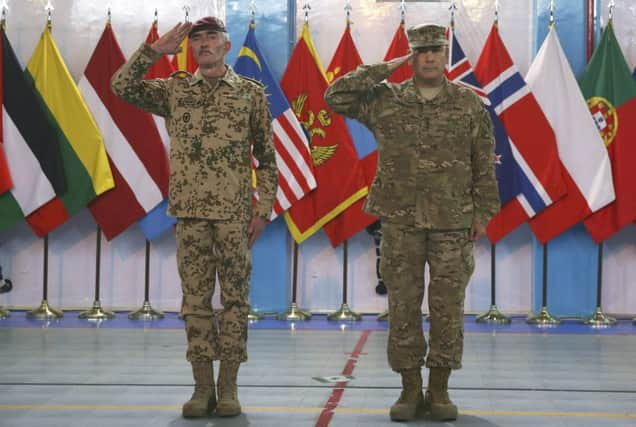US and Nato end war in Afghanistan


Despite the end of operations, the insurgency they fought for 13 years remains as ferocious as at any time since the 2001 invasion that unseated the Taleban regime following the 11 September attacks.
CONNECT WITH THE SCOTSMAN
• Subscribe to our daily newsletter (requires registration) and get the latest news, sport and business headlines delivered to your inbox every morning
Advertisement
Hide AdAdvertisement
Hide AdThe symbolic ceremony marked the end of the US-led International Security Assistance Force, (Isaf) which will transition to a supporting role with 13,500 soldiers, most of them American, starting on Thursday.
Isaf commander General John Campbell rolled up the green and white Isaf flag and unfurled the flag of the new international mission, called Resolute Support.
“Resolute Support will serve as the bedrock of an enduring partnership” between Nato he said.
He paid tribute to the international and Afghan troops who have died fighting the insurgents, saying: “The road before us remains challenging but we will triumph.”
From Thursday, the new mission will provide training and support for Afghanistan’s military, with the US accounting for almost 11,000 members of the residual force.
Afghan president Ashraf Ghani, who took office in September, signed bilateral security agreements with Washington and Nato allowing the enduring military presence. The move has led to a spike in violence as the Taleban has claimed it as an excuse to step up operations aimed at destabilising his government.
Isaf was set up after the US-led invasion as an umbrella for the coalition of 50 nations that provided troops and took responsibility for security across the country.
During the organisation’s tenure 2,224 US soldiers were killed, out of a total of some 3,500 foreign troop deaths.
Advertisement
Hide AdAdvertisement
Hide AdThe mission peaked at 140,000 troops in 2010 with a surge ordered by US president Barack Obama to root the insurgents out of strategically important regions, notably the southern provinces of Helmand and Kandahar, where the Taleban had its capital from 1996 to 2001.
Mr Obama recently expanded the remit of the US forces remaining in the country, allowing them to extend their counter-terrorism operations to the Taleban, as well as al-Qaeda, and to provide ground and air support for the Afghan forces when necessary for at least the next two years.
Afghans have mixed feelings about the drawdown of foreign troops, many believing that with the deteriorating security situation their presence is needed to back up the Afghan effort to bring peace after more than three decades of continual war.
“At least in the past 13 years we have seen improvements in our way of life – freedom of speech, democracy, the people generally better off financially,” said 42-year-old shop keeper Gul Mohammad.
“But we do need the foreign troops to stay here at least until our own forces are strong enough, while our economy strengthens, while our leaders try to form a government,” he said.
SCOTSMAN TABLET AND IPHONE APPS